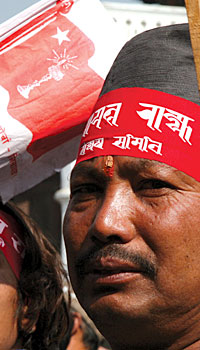 MIN RATNA BAJRACHARYA |
Ethnic identity is encapsulated within its language. Language is the link to its history, culture and customs. According to the 2001 census, there are 82 languages spoken in Nepal, but this diversity is being eroded, threatening the cultural identity of the people who speak them.
The Khas language, which until the Rana regime was known as Gorkha, is used in government, administration and education. It is drowning out other languages.
Language activists say Gorkha language speakers were biased and exclusivist towards other languages branding them as uncivilised. They imposed their language on other groups thereby weakening them by not acknowledging them. Some languages of indigenous groups are now on the verge of extinction.
Languages require non-interference and support from the state for their development and continuity. The state needs to have a single official language for administrative purposes, for national unity and to create a single political society. But the state made a mistake when it imposed a single language in the name of unifying the country because it infringed on multilingual rights.
Experiences of other countries show that a multilingual policy also consolidates national unity. In multilingual countries, school education is given in the mother tongue while other languages are taught alongside.
India has a long experience of multilingual education. Studies have shown that India's policy of schooling in three languages within a state has been very effective. Each Indian state teaches second and third languages alongside the state language. For instance, education is given in Bengali in West Bengal with Hindi taught as a second language and English as a third. India determined its federal structure primarily on the basis of language which has helped institutionalise democracy and bring about national unity.
South Africa mentioned nine indigenous languages along with English and Afrikaans as the official working language in its 1994 constitution. Similarly, New Zealand acknowledged the indigenous language Maori as the official working language in 1978. Under this provision, one can use this language in court, which has to provide an interpreter. Countries like Russia and China have also invested in the development of local languages and culture.
In Nepal, National Language Recommendation Commission 1994 studied the status of national languages and recommended a language policy. But not much has been done except the preparation of textbooks for primary level in a few indigenous languages. Although its recommendation for a three language policy was made 15 years ago, it is still relevant today and the federal structure should adopt it. But which languages should be used in schools, the media and administration is the issue to be debated.
TU professors are undertaking a language survey which should be taken into account when drafting the new language policy. But we can theoretically determine four practical aspects already. Firstly, primary education should be in the mother tongue and secondly, autonomous provinces should choose their official working language and language policy independently. Thirdly, there should be translation services available in state health and legal sectors and finally the state?and local provinces in a federal structure?must preserve and develop threatened languages.
In a pluralistic society, the use of many languages makes democracy all the more meaningful. In the past, Nepali speakers were considered more Nepali than non Nepali speakers, who felt a sense of alienation in their home country. It is a positive sign that many feel that language can be one of the cornerstones on which the federal structure is constructed.
Now that the monarchy as a symbol of national unity is gone, we need to find another foundation. The new constitution with its inclusive structure and multicultural policy will make a new foundation for national unity.



